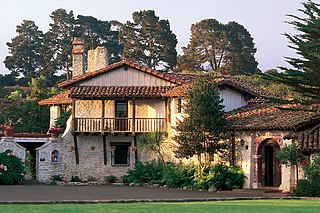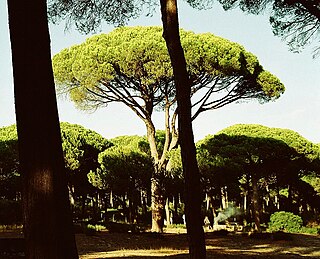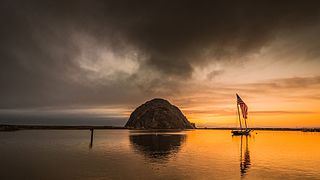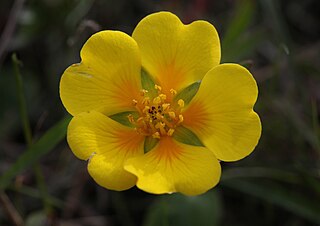
Founded on June 3, 1770, Monterey was the capital of Alta California under both Spain and Mexico until 1850. Monterey hosted California's first theater, public building, public library, publicly funded school, printing press, and newspaper. Monterey was the only port of entry for taxable goods in California. In 1846, the U.S. flag was raised over the Customs House, and California became part of the United States after the Mexican–American War.

Pinus radiata, family Pinaceae, the Monterey pine, insignis pine or radiata pine, is a species of pine native to the Central Coast of California and Mexico.

Grandview Park, also referred to as Turtle Hill by local residents, is a small, elevated park in the Sunset District, San Francisco, California. It is surrounded by 14th and 15th Avenues, as well as Noriega Street.

The stone pine, botanical name Pinus pinea, also known as the Italian stone pine, umbrella pine and parasol pine, is a tree from the pine family (Pinaceae). The tree is native to the Mediterranean region, occurring in Southern Europe, Israel, Lebanon and Syria. It is also naturalized in North Africa, the Canary Islands, South Africa and New South Wales. The species was introduced into North Africa millennia ago, such a long time that it is essentially indistinguishable from being native.

Urban forestry is the care and management of single trees and tree populations in urban settings for the purpose of improving the urban environment. Urban forestry advocates the role of trees as a critical part of the urban infrastructure. Urban foresters plant and maintain trees, support appropriate tree and forest preservation, conduct research and promote the many benefits trees provide. Urban forestry is practiced by municipal and commercial arborists, municipal and utility foresters, environmental policymakers, city planners, consultants, educators, researchers and community activists.

The Panhandle is a park in San Francisco, California, that forms a panhandle with Golden Gate Park. It is long and narrow, being three-quarters of a mile long and one block wide. Fell Street borders it to the north, Oak Street to the south, and Baker Street to the east. Only two streets run through it - Stanyan Street at the western end between it and Golden Gate Park and Masonic Avenue through the middle. Two paved walking paths run through it from Golden Gate Park to Baker Street, one allowing bicycles. There are basketball courts, a public restroom, and a playground in the section between Stanyan Street and Masonic Avenue.

The Oregon Dunes National Recreation Area is located on the Oregon Coast, stretching approximately 40 miles (60 km) north of the Coos River in North Bend to the Siuslaw River in Florence, and adjoining Honeyman State Park on the west. The Oregon Dunes National Recreation Area is part of Siuslaw National Forest and is administered by the United States Forest Service.

Morro Bay State Park is a state park on the Morro Bay lagoon, in western San Luis Obispo County, central California. On the lagoon’s northeastern and eastern edges in the park, there are saltwater and brackish marshes that support thriving bird populations.

Indiana Dunes State Park is an Indiana State Park located in Porter County, Indiana, United States, 47 miles (75.6 km) east of Chicago. The park is bounded by Lake Michigan to the northwest, and is surrounded on all four sides by Indiana Dunes National Park, a unit of the National Park Service; the national park owns the water from the ordinary high water mark to 300 feet (91 m) offshore. The 1,530-acre (619.2 ha) Dunes Nature Preserve makes up the bulk of eastern part of the park, and includes most of the park’s hiking trails and dune landscape. This was one of the first places Richard Lieber considered when establishing the Indiana State Park system. Like all Indiana state parks, there is a fee for entrance. Indiana Dunes State Park was established in 1925 and designated a National Natural Landmark in 1974.

Mount Sutro is a hill in central San Francisco, California. It was originally named Mount Parnassus.
William Hammond Hall was a civil engineer who was the first State Engineer of California, and designed Golden Gate Park in San Francisco, CA.

Potentilla hickmanii is an endangered perennial herb of the rose family. This rare plant species is found in a narrowly restricted range in two locations in coastal northern California, in Monterey County, and in very small colonies in San Mateo County. This small wildflower, endemic to western slopes of the outer coastal range along the Pacific Ocean coast, produces bright yellow blossoms through spring and summer.

Monterey County in California, U.S., has a commitment to its environment, and more specifically to its forestation, and offsetting the community's carbon footprint. To that end, a number of resources have been committed to preserving and improving this unique ecosystem and its reforestation.

Native trees in Toronto are trees that are naturally growing in Toronto and were not later introduced by humans. The area that presently comprise Toronto is a part of the Carolinian forest, although agricultural and urban developments destroyed significant portions of that life zone. In addition, many of Toronto's native trees have been displaced by non-native plants and trees introduced by settlers from Europe and Asia from the 18th century to the present. Most of the native trees are found in the Toronto ravine system, parks, and along the Toronto waterway system.

The Lost Forest Research Natural Area is a designated forest created by the Bureau of Land Management to protect an ancient stand of ponderosa pine in the remote high desert county of northern Lake County, in the south central area of the U.S. state of Oregon. Lost Forest is an isolated area of pine trees separated from the nearest contiguous forest land by forty miles of arid desert. There are no springs or surface water in Lost Forest, and much of the southwest portion of the natural area is covered by large shifting sand dunes that are slowly encroaching on the forest.

Lessingia germanorum is a rare species of flowering plant in the daisy family known by the common name San Francisco lessingia. It is endemic to California, where it is known from four populations in the Presidio of San Francisco and one occurrence on San Bruno Mountain south of San Francisco. It is a state and federally listed endangered species. The already rare plant is endangered by many processes, including invasive species, development, sand mining, off-road vehicles and bulldozers, habitat fragmentation, trampling, and pollution, as well as stochastic events.

The Bonny Doon Ecological Reserve is a nature preserve of 552 acres (2.23 km2) in the Santa Cruz Mountains of California, United States. The reserve protects several rare and endangered plant and animal species within an area known as the Santa Cruz Sandhills, an ancient seabed containing fossilized marine animals.

The city of Atlanta, Georgia has a reputation as the "city in a forest" due to its abundance of trees, uncommon among major cities. Tree coverage was estimated at 47.9% for 2008 in a 2014 study.
Urban reforestation is the practice of planting trees, typically on a large scale, in urban environments. It sometimes includes also urban horticulture and urban farming. Reasons for practicing urban reforestation include urban beautification, increasing shade, modifying the urban climate, improving air quality, and restoration of urban forests after a natural disaster.





















